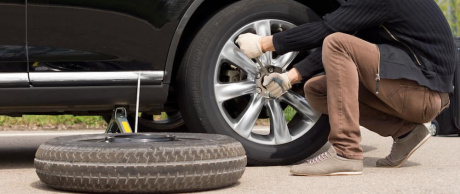
Changing tires might be a tricky business, especially for inexperienced drivers. Most people prefer technicians or skilled DIYers to handle flat tire replacement. That’s all good, but it is always even better to have a theoretical understanding and hands-on practice.
No one knows what life has in store for them. There could be a rainy day, there could be no help or assistance, so it’s better to know how to do it yourself. Keep reading this article and by the end, you'd know what to do if there's a flat tire you have to change.
Before You Begin to Practice-Changing a Flat Tire
The best practice is to follow the steps practically instead of just reading them. This practice will save the day for you if there ever comes a need. So, get ready and find your car on a flat paved surface to park.
Before you start, always remember to carry all the necessary tools with you in your car's trunk. Your spare tire should be there as well, because why not! And if it's not there, then buy a spare tire as soon as possible.
What You Need To Change a Flat Tire
So, make sure you have the following items with you before you set foot on your journey.
- A spare tire: You've got to have a spare tire with you in your car's trunk. Because performing a pantomime without a tire to replace with might not look cool. If you have a truck, then check beneath the bed. Crossover & SUV owners know their spare tire is sticking happily with the rear door.
- Jack: You'd need a jack to lift your car.
- Lug wrench: Hexagonal heads of lug nuts require an all-rounder lug wrench.
How to Change a Flat Tire?
Once you're sure you have all the necessary items, park your car in a safe place with fewer traffic, like a quiet corner in a street or a parking lot. A flat surface is desirable to work upon as it cuts down the risk of a rolling vehicle. Display hazard warning signs (triangles) to make it known to others about your disabled car. Now, follow the steps:
- Unpack the tools and necessary items
- Loosen the nuts using a lug wrench by rotating it anti-clockwise. And loosen them, don't remove them altogether. You don't want your vehicle to drop to one side entirely.
- Place your jack in such a position where it can easily lift a section of frame & not the entire vehicle.
- Roll the jack to lift the vehicle frame so that the flat tire can be removed.
- Remove the heel of the flat tire using the lug wrench
- Align spare tire with wheel studs to place it on
- Screw the lug nuts by hands to maintain grip
- Loosen the jack through its crank to lower down the vehicle until the lifted tire touches the ground.
- Tighten lug nuts to the point where the nuts don't move anymore.
- Drive to your technician to get it checked. Do not overuse your spare tire, and limit it to 50 miles.
And remember, it's always better to keep an eye on your regular tires so that the need for urgent replacement can be minimized.
Same articles

Understanding Vehicle Inspection and Verification Services: Why They Matter for Every Driver
GuidesVehicle inspection and verification services are an essential but often overlooked part of keeping roads safe and cars legally compliant. Most people only think about inspections when it’s...
KLIFEX Brand Overview: High-Quality Automotive Repair Kits for Affordable Repairs
GuidesThe automotive aftermarket has long needed solutions that combine reliability, durability, and affordability. Many car enthusiasts and services are looking for a way...
Fast, Reliable Vehicle Emissions & Inspection Services Made Simple
GuidesFast, reliable emissions and inspection services are essential for keeping vehicles road-ready, compliant with environmental regulations, and safe for daily driving. If you’re looking for quick...

